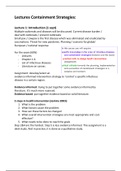Samenvatting
Summary Exam Containment Strategies 2020
- Instelling
- Vrije Universiteit Amsterdam (VU)
Made this summary myself for the master MPA in the year 2o20. Hope you can use it! It covers the complete course in the time of covid-19, so online education. My end grade for this exam was 8,5!
[Meer zien]








